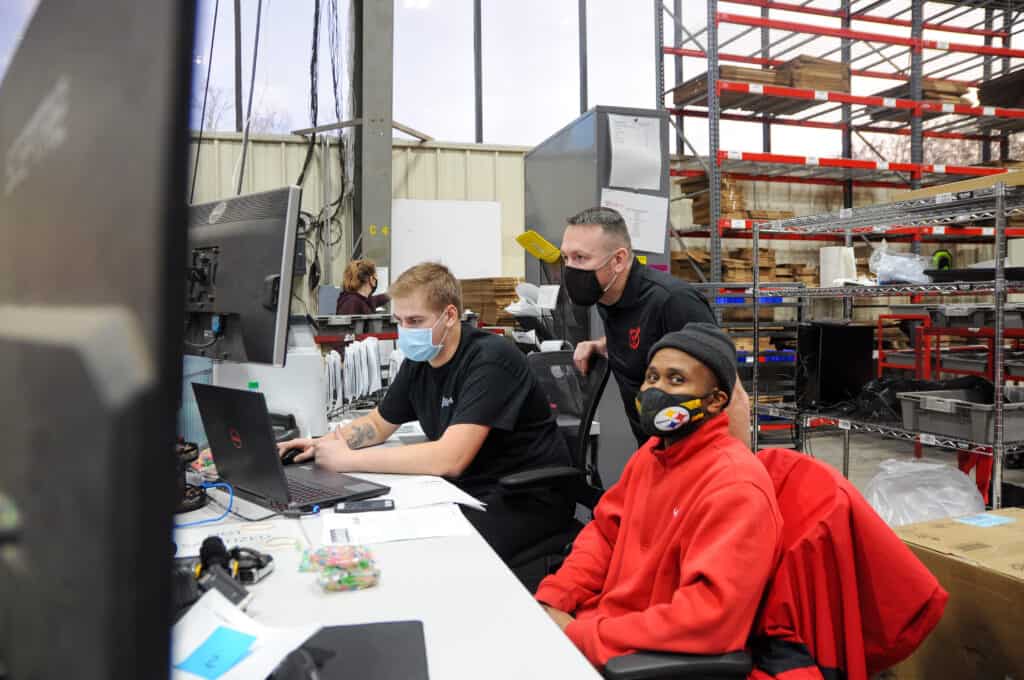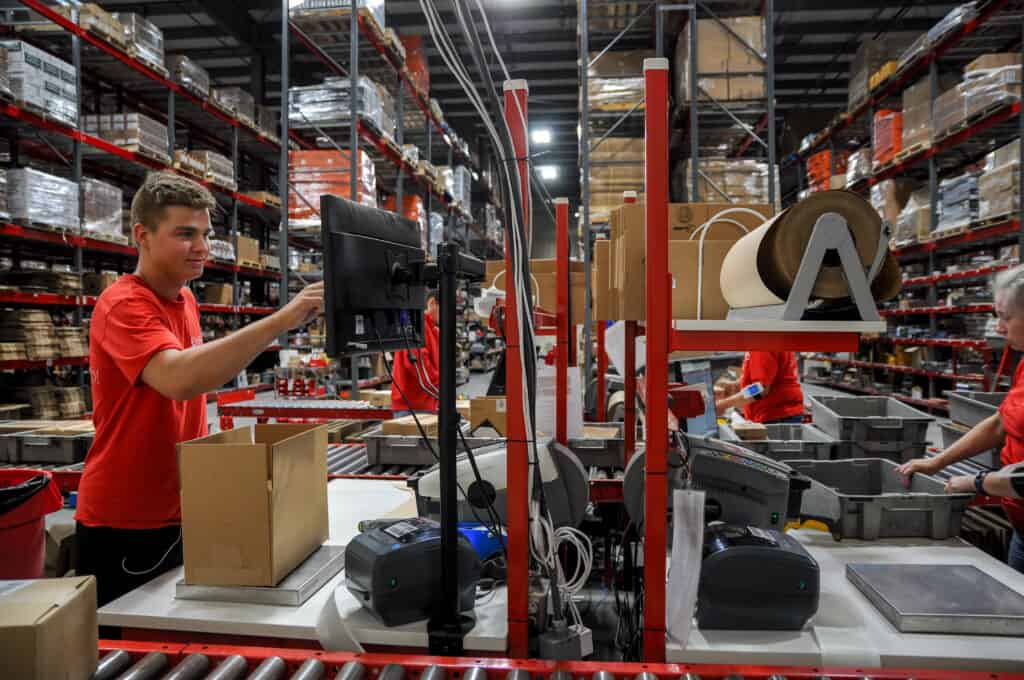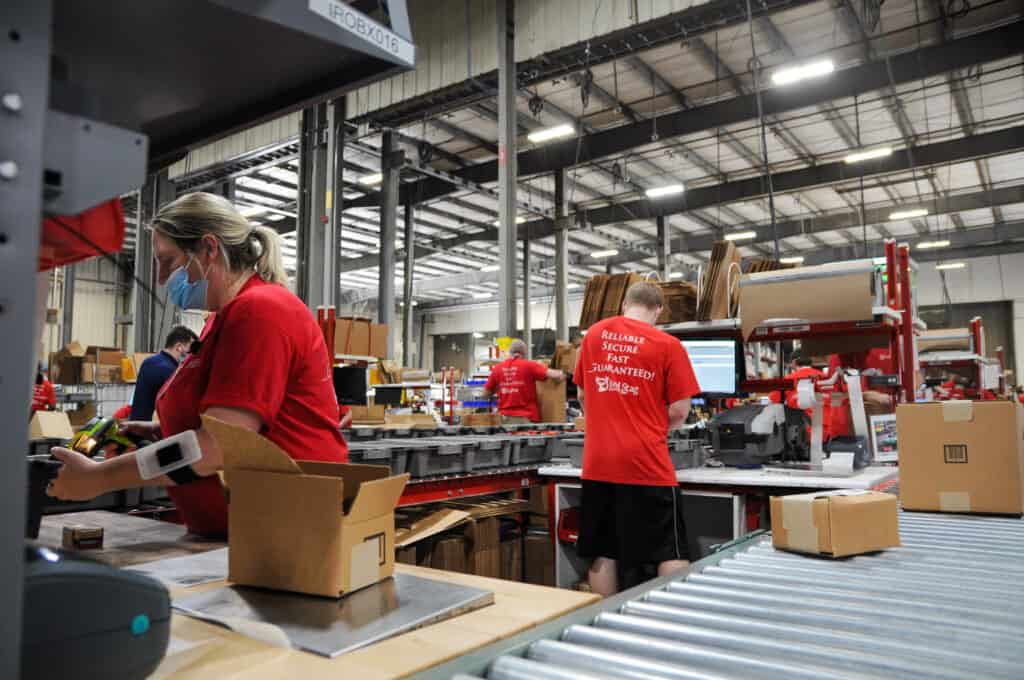The eCommerce distribution system is never static, as new technologies cause fundamental changes in how distribution works. Societal disruptions, like those caused by the COVID-19 pandemic, can also lead to changes in the way producers and supply chain managers handle their distribution networks, including eCommerce fulfillment. The future of distribution is changing more quickly every year.

Producers, distributors, and retailers compete for market share and a bigger slice of the overall pie with unpredictable outcomes. Using innovative approaches, some companies attempt to cover an entire market segment, from production to retail. Others specialize in becoming an all-purpose intermediary or try to excel in a particular niche. Examining which new technologies are likely to roll out over the next few years and how they will impact the existing distribution system can yield clues to the future of distribution.
Distribution Yesterday and Today
A historical perspective and an overview of today’s distribution system will help put future developments into perspective. While manufacturing and consumer needs change relatively slowly, the distribution system can change overnight as companies implement disruptive new technologies. Those businesses not adapting get left behind.
Manufacturing develops new technologies, but it takes time to change production lines, test new products, and ramp up new production. Consumer needs change too, but the basics remain the same. Neither applies in distribution. Processes such as shipping, warehousing, purchasing, and selling can change very quickly. The only underlying requirement is to get the right product to the customer that wants it in the most efficient way possible.
Distribution and Wholesaling

Distribution as a separate function became widespread when mass production started in the 1900s. Previously local manufacturing had supplied local markets either directly or through local merchants. Large manufacturing plants could churn out large quantities of inexpensive products with mass production, but they lacked ties to a specific market. The people who owned and operated these plants were investors, technical people, and workers. Salespeople did not naturally fit into a manufacturing plant’s organization.
Wholesalers filled the gap. A traditional supply chain consists of a manufacturer that produced the goods, a wholesaler that bought in bulk from the manufacturer, and retailers who buy small quantities from the wholesaler and offering products to customers. The savings from mass production were so great that wholesalers could often sell to retailers at double the price they paid to manufacturers and the retailers in turn doubled the price again.

Other Supply Chain Models
Some industries organize themselves slightly differently. The auto industry sells through dealers tied to a particular manufacturer. The oil industry sells gas through branded service stations. Direct marketing organizations cut out one level by buying from manufacturers and selling directly to consumers. These models have one thing in common with the wholesale model: producers receive a small percentage of the final price. Plus, alternative methods were not able to spread throughout the distribution system.
The Internet Disrupts Existing Distribution Models

With the development of the Internet, new and more compact models emerged. Disintermediation became a catchword and meant that producers would finally be able to sell directly to consumers. The value added by intermediaries would no longer be significant, and manufacturers would receive a larger share of overall revenue while consumer prices would drop.
This didn’t happen. Intermediaries became stronger, and manufacturers had to reduce costs because new distributors controlled market access.
The Producer Approach
Disintermediation through improved technology and the Internet, in fact, took place, but not through the disappearance of distributing companies. Instead, new and existing companies operating in the distribution space took over a wider range of functions and increased their power.
Some companies attacked the traditional supply chain from the producer end. Dell Computers pioneered a model in which a computer manufacturer could sell directly to customers online. Tesla offers the cars it manufactures directly to consumers via its website. Many high-tech product manufacturers use a hybrid model to sell both online and through more traditional channels.

The Retail Approach
Other companies entered the distribution channels from the retail end.
Walmart is the biggest example of a retailer stepping up the supply chain to control manufacturing as well. Wholesalers did it for them. Using Internet communication and computer technology, Walmart built automated structures to carry out these tasks. As a result, Walmart was able to offer lower prices than traditional retailers.
Amazon did away with traditional retail altogether and sold a wide variety of products online. Apple is solidly situated on the retail side of distribution but pays factories it doesn’t own to build its products. Instead of producers gaining power in the new distribution field dominated by technology, new and powerful intermediaries have sprung up to control markets and dictate pricing and conditions to producers.
Approaching distribution from the retail side has made some companies extremely profitable. Businesses that control a market segment and a large client base can achieve savings on the supply side from manufacturers and charge above-market prices to consumers. Margins can be substantial because these businesses have taken control of the distribution mechanisms and the profits that were formerly associated with them.
New Technologies Waiting in the Wings

There are several new technologies that have either already impacted distribution or will soon do so. The new, powerful, and highly profitable companies active in the distribution space have strong incentives to introduce new technologies, both to further increase profitability and to consolidate their power. RFID tags (radio frequency identification tags) are already in use and will become a much more disruptive influence. Very short delivery times where orders from companies such as Amazon are delivered within the hour are possible but not commercially viable at scale yet.
The Synchronized Supply Chain
When a single company controls the entire supply chain, such as Walmart, Apple, and Amazon do to varying degrees, it can develop procedures that greatly simplify and speed up distribution. Ideally, there is a small and relatively constant number of particular products in the chain and, as a customer buys one, an additional one is placed on order from the factory. The key is to coordinate so only the number of products actually sold is produced. To achieve a synchronized supply chain, companies have to know where each product is at all times. One technology that facilitates this is the RFID tag.
RFID tags are already used in warehouses, on assembly lines, and in retail. They consist of a small tag with an electronic circuit that can send identification information to a reader when the reader sends them a radio signal query. Inexpensive ones are passive and respond only to queries. The more expensive ones contain a small battery and can send identifying signals for several hundred feet. The product ID generated can be unique and can contain product-related information. In a warehouse, for example, an automated reader can query a newly arrived pallet of products and receive detailed information about the products in the pallet.
Unlike bar codes, which fulfill a similar function, RFID tags don’t have to be in the reader’s line of sight and can identify individual products. RFID tags are more expensive than barcodes. However, if they allow synchronization of a supply chain, the savings can be substantial. A business can aggregate the RFID readings from many sources and know exactly where the products are and how many are in the distribution channel.
Automated Warehouses
When new automation technology is combined with RFID tags, fulfillment centers can be completely automated. There is no need for inventory because businesses know in real-time what is in their warehouse. Stacking and storing on shelves is relatively easy to automate, but the challenge lies in reliably retrieving a specific product. So-called picking robots can distinguish items of different shapes and sizes and pick up the one to be shipped. The problem is that picking and packing robots are still much slower and less accurate than human workers.
The difficulties and problems robots have are being addressed and eventually the performance of such robots will surpass that of humans. The completely automated warehouse will then quickly become commonplace.

Artificial Intelligence Powers Smart Distribution Systems
AI and machine learning have changed many aspects of life, and distribution systems are no exception. Using algorithms to parse data on sales, inventory, and logistics quickly, companies will be able to pivot more quickly than ever.
In the past, global distribution networks have been as difficult to change as turning a huge container ship around. However, the power of AI lets managers make better demand forecasts and inventory planning decisions.
Last-Mile Solutions Speed Deliveries
Rather than sending lumbering, gas-guzzling deliver trucks on long routes, some carriers have already begun to take a different approach. You may have noticed smaller, more nimble delivery vans in your neighborhood from companies such as Amazon. Sending a fleet of smaller delivery vehicles from a central distribution point can quickly get orders to consumers.
One future option for last-mile delivery in the future may be delivery drones. Pilot projects for distributing small but high-value and time-sensitive items, such as prescription medicines, have been undertaken in various countries. However, don’t expect to see drones dropping boxes into your yard anytime soon.
A decentralized delivery system with more options for last-mile delivery has practical benefits. For example, limits on carrier capacity slowed eCommerce deliveries during the pandemic holiday season in 2020. In response, Red Stag Fulfillment broadened its distribution network, adding smaller carriers to fill in the gaps that FedEx, UPS, and USPS couldn’t handle. By stepping into the future of distribution, we were able to ship almost all our orders on time.
The New Distribution System
Order fulfillment will be a different experience for many consumers in the near future. Here’s what the future of distribution might look like in practice.
Quick Delivery of a Small, Common Product
Once an automated supply chain is in place, delivery of everyday products is likely to be quick and inexpensive. If a consumer orders a product such as a popular toy action figure, such products will probably be in local warehouses. A picking robot working in an automated warehouse with that figure in stock will have the order added to its list. The software will re-optimize the list, so the robot makes as few trips as possible. The toy will probably be picked up and placed on a conveyor belt for automatic wrapping, boxing, and addressing within the hour.
The conveyor belt will bring the box to a pickup platform where delivery drones pick up packages in sequence. Only local orders go here; the others go to an automated truck loading dock. Since the toy order is local, a drone reads the address, plots a corresponding course, and takes the package to its destination. Later that day, the customer comes back from work and finds the package in the designated landing area by the back door. The customer retrieves the box, and the toy is ready for a child’s birthday the next day.
Ordering an Unusual Item
Often customers order items online that they can’t find locally. If a customer orders an unusual item, it probably will not be in a local warehouse. When the customer places the order online, the supplier will know where the closest product is located and automatically put a hold on it.
Once the customer’s payment has cleared, the supplier will place the corresponding order, which may be in a warehouse 500 miles away. The packaged order is routed through a smart distribution system that finds the most efficient carriers for each leg of the trip. This could be a combination of air and ground transportation, ending with last-mile delivery options. Within days, even the most unusual item from the most distant warehouse will arrive at the customer’s doorstep.
As the demand for fast eCommerce shipping increases, technological advances in distribution will continue to meet that demand.

Choose a 3PL at the Forefront of New Fulfillment Technologies
The future of distribution is likely to include the technological innovations described above and more that haven’t been envisioned yet. Expect these technologies to save money, allow more rapid deliveries, and be more convenient for customers.
Ecommerce companies will have to adopt new technologies to keep up with the competition. It may be easier to scale into new tools with a 3PL. That’s why partnering with a 3PL services company like Red Stag Fulfillment is a great way to keep your company up to date. We help ensure that you can take advantage of the latest innovations and best practices in fulfillment, logistics, and distribution.






